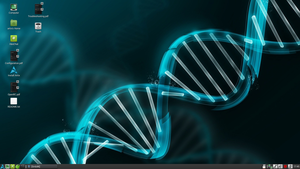Artix Linux
 | |
 | |
| Developer | Core team[1], Developer team[2], Support staff[3] |
|---|---|
| Written in | C |
| OS family | Unix-like |
| Working state | Current |
| Source model | Open-source |
| Latest release | 2020-02 / February 14, 2020 |
| Latest preview | https://artixlinux.org/download.php#weekly |
| Repository | gitea |
| Package manager | pacman |
| Platforms | x86-64 |
| Kernel type | Monolithic (Linux) |
| Userland | GNU |
| Default user interface | LXQt, LXDE, MATE, Cinnamon, Plasma, XFCE |
| Official website | artixlinux |
Artix Linux, or Artix is a rolling-release distribution based on Arch Linux that uses OpenRC, runit or s6 init instead of systemd.
Artix Linux has its own package repositories but, as a pacman-based distribution, can use packages from Arch Linux repositories or any other derivative distribution, even packages explicitly depending on systemd. The Arch User Repository (AUR) can also be used.
Arch OpenRC[4] began in 2012[5] and Manjaro OpenRC was subsequently developed alongside it. In 2017[6][7] these projects merged to create Artix Linux.


Release history
Artix initially offered two installation environments, a base command-line ISO image and the graphical Calamares installer based on LXQt desktop[8] with an i3 version following later.[9] Those early versions featured the OpenRC init system. The latest installation media are available in a variety of desktop environments like LXDE, XFCE, MATE, Cinnamon and KDE Plasma 5.[10] Additionally, two unofficial community editions featuring GTK and Qt desktops and a larger software base are offered, aiming at too-busy-to-customise or less experienced users.[11] All current installation media come in OpenRC, runit and s6 versions.
Reception
An early review published on DistroWatch on 27 November 2017 found a few bugs, but overall "Artix is working with a good idea [...] It's minimal, it is rolling and it offers a little-used init system. All of these I think make the project worthwhile."[12] A later (July 2019) review from Softpedia gave Artix a 5 out of 5 stars rating, noting its "beautiful and pleasant graphical environments."[13] Distrowatch readers' reviews on Distrowatch are mostly very favourable, with an average rating of 8.4.[14]
References
- ^ "These people started Artix". ArtixLinux.
- ^ "These people make Artix run". ArtixLinux.
- ^ "These people take care of the community". ArtixLinux.
- ^ "Archlinux, systemd-free". systemd-free.artixlinux.org. Retrieved September 4, 2019.
- ^ "OpenRC & eudev on Arch / AUR Issues, Discussion & PKGBUILD Requests / Arch Linux Forums". bbs.archlinux.org. Retrieved September 4, 2019.
- ^ "Return of the Jedi". systemd-free.artixlinux.org/news.php. Retrieved April 14, 2020.
- ^ "Manjaro-openrc will be discontinued". Manjaro Linux Forum. July 28, 2017. Retrieved September 4, 2019.
- ^ "Early Artix Linux ISOs". Retrieved April 8, 2020.
- ^ "Early Artix Linux ISOs / i3". Retrieved April 8, 2020.
- ^ "Artix Linux minimal ISOs". Retrieved April 8, 2020.
- ^ "Artix Linux community ISOs". Retrieved April 8, 2020.
- ^ "First Artix Linux review at Distrowatch". Retrieved April 4, 2020.
- ^ "A simple, fast, systemd-free operating system based on Arch Linux and OpenRC or Runit". Retrieved April 27, 2020.
- ^ "Reader supplied reviews for Artix Linux". Retrieved April 8, 2020.
